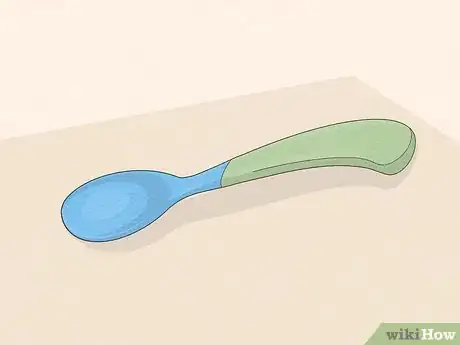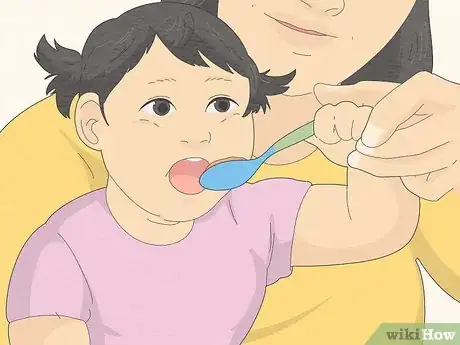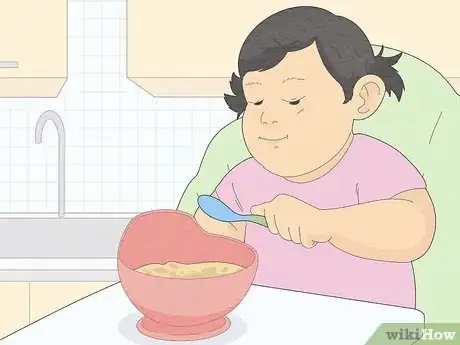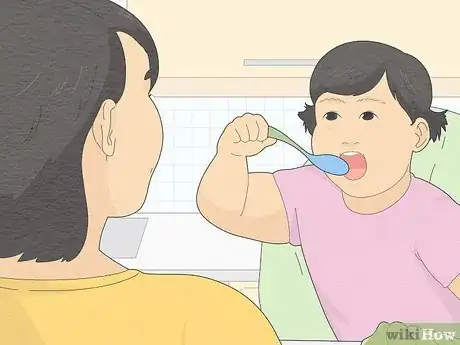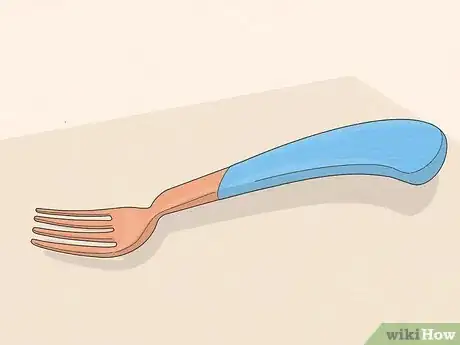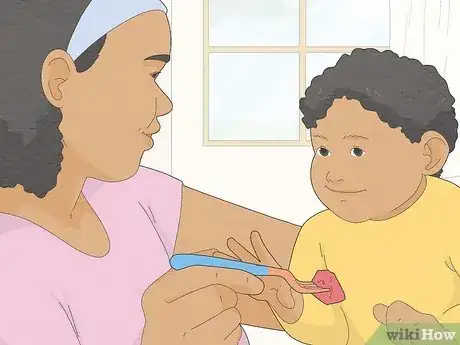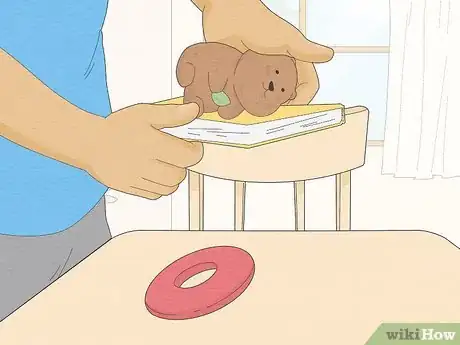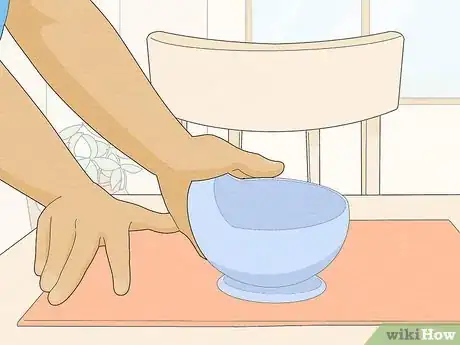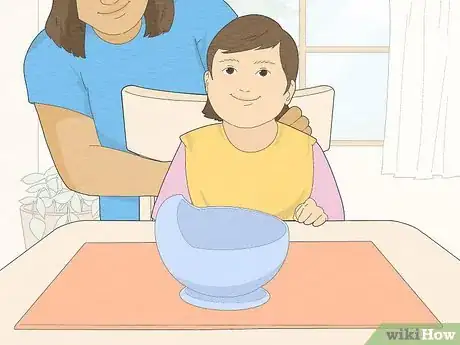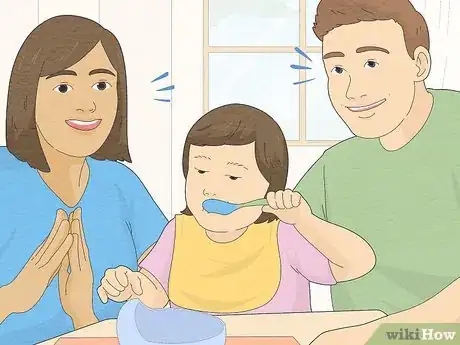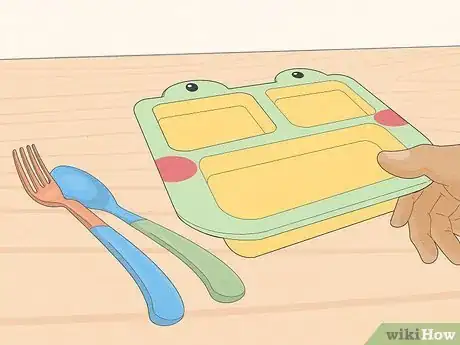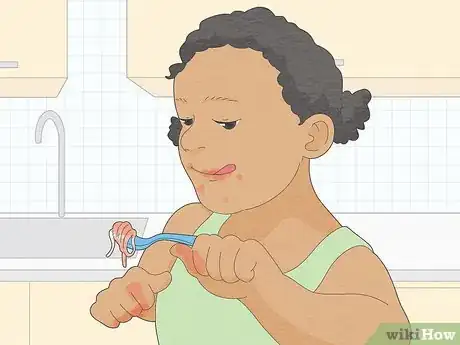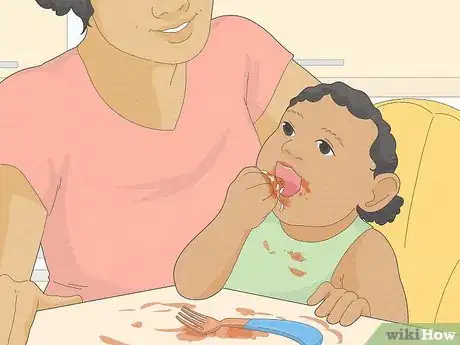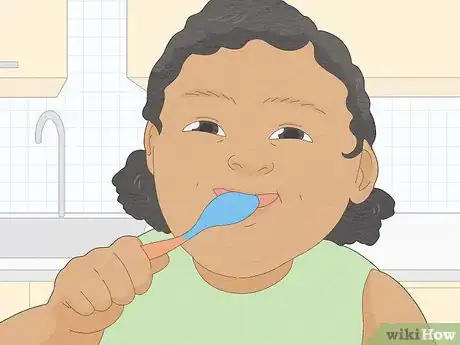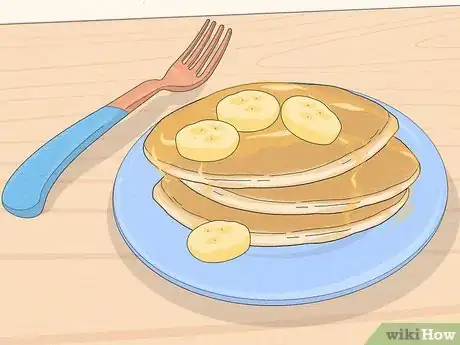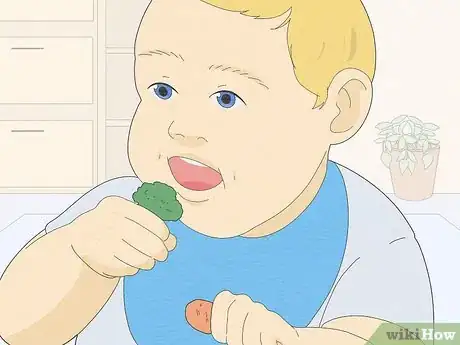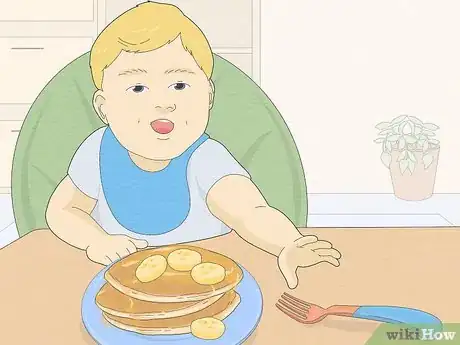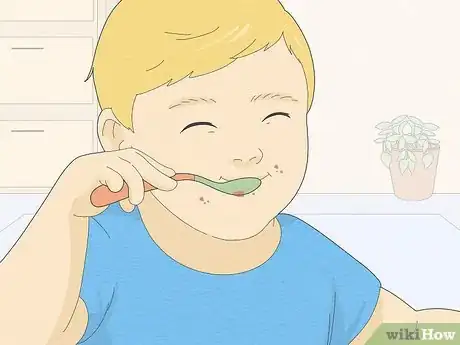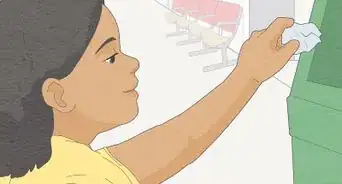X
wikiHow is a “wiki,” similar to Wikipedia, which means that many of our articles are co-written by multiple authors. To create this article, volunteer authors worked to edit and improve it over time.
This article has been viewed 61,996 times.
Learn more...
As your child grows and develops, so does her need to be more independent. She will want to do more and more things on her own. Usually, the first things a growing child will want to try on her own include feeding herself, dressing herself, and brushing her own teeth. Toddlers generally start using utensils when they hit the 18 to 24 month mark. You can help your child explore her independence by teaching her how to use utensils and how to feed herself.
Steps
Method 1
Method 1 of 5:
Teaching Your Child to Use a Spoon
-
1Give your child her own ‘toddler spoon’. While your child is learning how to use a spoon, do not have her use regular adult utensils. These heavier metal utensils can hurt your child’s gums or teeth. Your child may also find them too heavy to maneuver. Instead, purchase your child’s own set of plastic, toddler-sized spoons.[1]
- Toddler spoons are often tipped with soft rubber to make it easier to grip the handle.
-
2Help guide your child through the movement of eating with a spoon. If your toddler is still learning how to handle her spoon, you can help her by putting your hand over hers. Move her hand through the whole process of scooping up the food and then bringing the spoon to her mouth.[2]
- Do this movement much more slowly than you would to eat with a spoon yourself. Your child is still adjusting to the feeling of eating with a utensil.
Advertisement -
3Give your child a little food to practice with. Place a small amount of food in a bowl so that your toddler can practice using her spoon. Putting a small amount of food in the bowl will help if she accidentally swipes the bowl and spills its contents.
- Have another bowl with more food ready on the sidelines. When she has used the spoon to eat the small amount of food in her bowl, add some more food from the second bowl.
-
4Stay by your child’s side while she practices using the spoon. Your child will most likely adapt to using a spoon quickly. However, you should still stay by her side while she practices so that you can help her with large bites, or with tilting the spoon the right way if the food is about to slide off of it.
- Your child will most likely continue to be a messy eater until she reaches the ages of 2.5 or 3.[3]
Advertisement
Method 2
Method 2 of 5:
Teaching Your Child to Use a Fork
-
1Choose the right fork for your toddler. When choosing a fork for your toddler, choose ones that have a wide grip handle with a rubber coating for easy grip.
- Look for toddler forks with metal prongs instead of plastic ones so that you are sure that it can penetrate the food, but make sure that the prongs are blunt or rounded so it won’t be dangerous for your toddler to use.
-
2Introduce the fork to your child soon after she starts using a spoon. Show her how to poke or stab the food in her bowl. It may take some getting used to before she can really tell the difference between the fork and the spoon; this means she may try to use a fork in the same way she would use a spoon. Some foods that you can give to your child so that she can practice stabbing her food include:[4]
- Boiled or cooked vegetables like potatoes or carrots that have been cut into chunks.
- Chunks of fruit like melons, apples, watermelon, or bananas.
- Chunks of chicken and small cut up pieces of bread.
-
3Help your child to stay positive. Try to keep your child from getting discouraged by giving her food that is easy to eat with a fork (see the previous step). Avoid foods that are harder to eat in order to keep her positive and motivated. When your child is able to eat harder foods, make sure to praise her for her excellent work.
- Noodles can be a challenging food to eat with a fork. Make sure that you are right next to your toddler to provide support and encouragement if she is eating noodles like spaghetti.
Advertisement
Method 3
Method 3 of 5:
Setting Up a Practice Area
-
1Set up a distraction-free zone that is easy to clean. When practicing or teaching your toddler to self feed, try to prepare the area where you will feed her to lessen your frustration (and added work!) and capitalize on her success, which is the most important part in this whole experience. When feeding, make sure that there aren’t other things on her table or nearby that will distract her from eating.
-
2Protect against spills. Put down a mat or towel under the bowl or plate you give to your child. Doing this will make cleanup easier. You can also protect your child from spills by putting a toddler bib on her. The bib should cover most of your toddler’s chest so that her clothing is protected.[5]
- If you don’t have a bib, dress your child in old clothing that you don’t have an attachment to. By doing this, you won’t have to go through the hassle of trying to get a stain out if your child spills on herself.
-
3Make a place for your toddler at the family dining table. Sit your toddler at the dining room table together with the whole family during Mealtime. Yes, it can be quite a long Mealtime when you have to wait for her to finish her meal, but it is important that she see every member of the family eating with utensils.
- Keep in mind that you and your family are role models. Show her how you use your utensils so that she learns by observation.[6]
-
4Encourage and praise your child while she learns how to eat with utensils. Encouragement and praise are key to helping your toddler use her own utensils. When she finishes her meal on her own, however messy it got, praise her and tell her she did a good job. This will give her confidence the next time she eats.
Advertisement
Method 4
Method 4 of 5:
Creating a Positive Mealtime
-
1Create a schedule for meals. Creating an eating schedule will help to teach your child that eating is a part of everyday life and that feeding herself is something she will need to be able to do when she grows up.[7]
- However, just because meals should be routine does not mean that they should be lacking in fun. Pick out colorful toddler utensils, plates, and bowls for your child to eat off of. Look for ones with fun designs like pictures of dinosaurs or animals.
-
2Support your child when she wants to be independent. There will be days when your child will simply want you to feed her and that’s okay. The next day, you may find that she is again up to the task of feeding herself. Her desire to feed herself is your chance to let her have at it.
- Be prepared for your child’s independence to be messy; remember that you are teaching her a life skill—a little pasta sauce on your tablecloth is worth it.[8]
-
3Remember that mistakes are ok. Reassure your child when she makes a mistake, no matter how messy that mistake may be. The important thing is that she learns from her mistakes and keeps on practicing.
- Try not to get frustrated when she makes a mistake and food goes flying. While it may be annoying to clean up after your toddler, learning how to use utensils is an essential part of your toddler’s early life. Keeping a positive attitude will help your child to keep trying.
-
4Explain what you are doing during meal times. Explain why you are choosing to use a spoon, rather than a fork, when you eat cereal with milk. Likewise, explain the necessity of using a fork when eating pasta.
- Helping your child to understand your choices will help her to make her own choices in the future.
-
5Be patient and reasonable. Give allowances during feeding time and be reasonable with your expectations. You can’t expect her to finish all of her food in five minutes just because you said so. Know that feeding time can be daunting to her as well. The important thing is to make sure that feeding time should be an enjoyable time for both you and your toddler.
-
6Try to incorporate variations of your child’s favorite food into each meal. If your child loves spaghetti, try introducing her to other pastas or using a different sauce. If she loves bananas, add them to her pancakes, oatmeal or yogurt. Doing this will help to keep her interested in her food so that she can keep practicing using her utensils.
Advertisement
Method 5
Method 5 of 5:
Determining If Your Child is Ready for Utensils
-
1Give your child finger foods before asking her to use a spoon. Your toddler may be ready to use a spoon by the time she reaches 12 to 15 months old. [9] However, if you have not introduced her to finger foods by that time, you should do so before starting to teach her how to use a spoon. Eating finger foods will help your child to learn how to bring food to her mouth. Finger foods include:
- Chunky slices of fruits and vegetables.
- Dry crackers and cereals.
-
2Watch out for signs that your child wants to use a spoon. After your toddler has gotten used to eating with finger foods, you may notice that she starts eyeing your utensils during Mealtime. She might even indicate her desire to hold a spoon. If you see this happening, allow her to try using the spoon all by herself.
- Be prepared for a mess and always remember to applaud her efforts.
-
3Understand that your child’s dexterity will take time to develop. By the 18th month, your child will most likely have figured out how to use the spoon properly though there will still be times when she will revert back to using her hands to feed herself. She will revert back to finger foods because at this stage her dexterity is still not that developed.[10]
- To help your child’s dexterity, give her foods that will stick to the surface of the spoon.
Advertisement
Community Q&A
-
QuestionMy child will pick food up with a utensil, but then take it off with their hands to eat it. What should I do?
 Community AnswerThis might be a good transitory stage. I would recommend continuing to encourage your child to eat with the utensils, but don't freak out if they use their hands now and then. Just gently remind them that they should use their fork or spoon instead, and eventually they will grow out of using their hands.
Community AnswerThis might be a good transitory stage. I would recommend continuing to encourage your child to eat with the utensils, but don't freak out if they use their hands now and then. Just gently remind them that they should use their fork or spoon instead, and eventually they will grow out of using their hands. -
QuestionMy toddler stopped using utensils. What can I do?
 MARY BODDENCommunity AnswerHe probably saw someone using their hands and decided to copy it. Try and figure out who it was and make sure he does not see them eat.
MARY BODDENCommunity AnswerHe probably saw someone using their hands and decided to copy it. Try and figure out who it was and make sure he does not see them eat.
Advertisement
References
- ↑ https://www.fatherly.com/health-science/toddler-spoon-fork-expert/
- ↑ https://yourkidstable.com/teach-your-child-to-feed-themselves/
- ↑ https://yourkidstable.com/teach-your-child-to-feed-themselves/
- ↑ https://www.fatherly.com/health-science/toddler-spoon-fork-expert/
- ↑ https://www.betterhealth.vic.gov.au/health/HealthyLiving/toddlers-and-mealtime-manners
- ↑ https://www.betterhealth.vic.gov.au/health/HealthyLiving/toddlers-and-mealtime-manners
- ↑ https://www.betterhealth.vic.gov.au/health/HealthyLiving/toddlers-and-mealtime-manners
- ↑ https://yourkidstable.com/teach-your-child-to-feed-themselves/
- ↑ http://www.babycenter.com/0_toddler-milestone-self-care_11740.bc
About This Article
Advertisement
